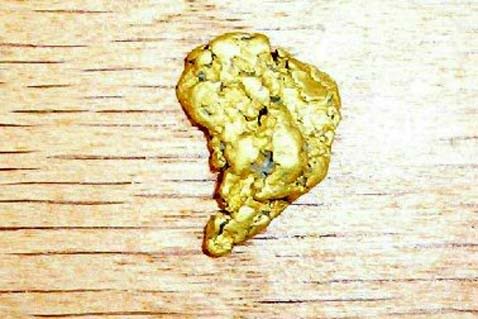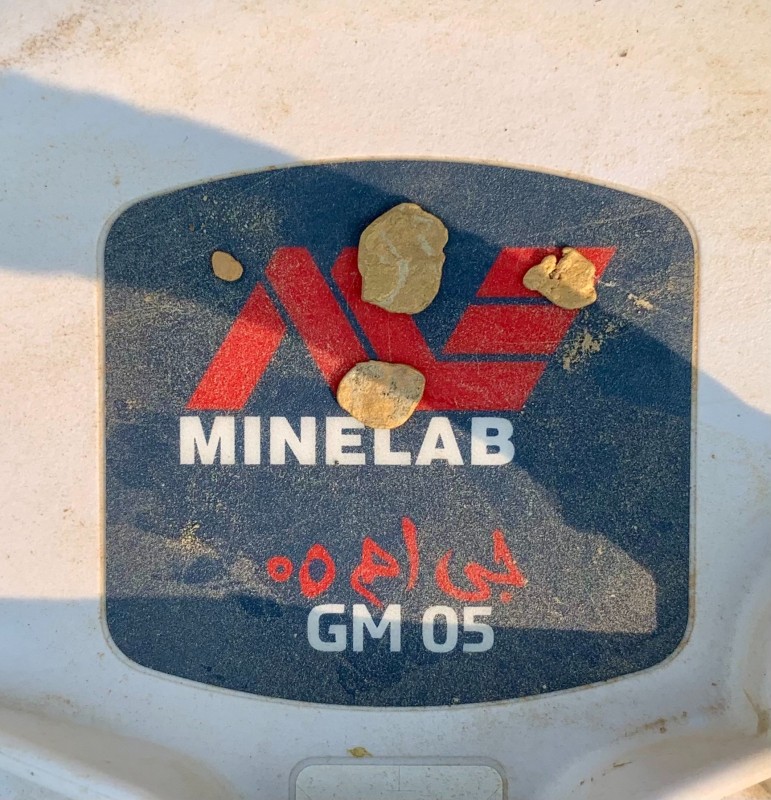-
Posts
785 -
Joined
-
Last visited
-
Days Won
6
Content Type
Forums
Detector Prospector Home
Detector Database
Downloads
Everything posted by Lanny
-
That sure is some nice gold you're finding, congratulations! All the best, Lanny
-
Nice finds Condor, hope you find one big enough to use for a doorstop. All the best, Lanny
-
The Monster is a fine, fun little machine, super sensitive and a proven gold-getter that's light enough to swing basically forever. One day when my son and I were off to get some nuggets, we arrived, at our spot, but no battery in the Monster! The cam-lock/cover wasn't seated, and the battery was nowhere to be found. We pulled everything out of the truck, checked everywhere, even crazy places, no battery, just an open compartment. We carried on with the day with our other detectors. . . . When we got back to the gold camp, we pulled everything out of the truck and searched again, no luck. At about that time, I started to question if it fell out before we'd left camp, so we searched everywhere we possibly could have walked with the detectors before loading them up, no luck. I thought I was losing my mind or something, how could it have just disappeared? Well, in the truck we had a plastic wrapped six-pack of toilet paper, with one roll out. The battery had dropped from the detector and was underneath the bottom three rolls of paper!! So, I'm glad you're getting a new battery, and Kudos to Gerry for his lightning-fast service. On a different note, after reading your post about the AA battery pack, I'll dig mine out to see if it fits or not, as I didn't have mine with us the day my regular battery did its disappearing act. All the best, Lanny
-

Dumping Minelab GPX 6000 For Garrett Axiom?
Lanny replied to Steve Herschbach's topic in Metal Detector Advice & Comparisons
Great write-up on explaining your position on the whole issue Steve. Really enjoyed the read, and I wish you happy hunting as you continue testing the Axiom, especially in Australia. What a fantastic opportunity! (Australia is still on the bucket list for me, not only for detecting, but for scuba on the Great Barrier Reef as well.) All the best, Lanny -
Yes, Germansen Landing, been there multiple times. Lots of good gold history, and nice chunky gold as well. All the best, Lanny
-
That is one sweet piece of an amazing gold specimen. What a fantastic item to have on display. Thanks for the link, and all the best, Lanny
-
British Columbia is where I spend most of my time chasing the gold. Great gold rush history in multiple places, and B.C. is known for its nuggety gold. The monster nuggets are up around Atlin, in northern British Columbia, also the site of a long ago gold rush. B.C. is a continuing series of mountain ranges heading east to west across the province, lots of places to get lost in, lots of things still to be discovered, and the vastness of the wilderness places still intact boggles the mind. All the best, and thanks for the link, Lanny
-
First nugget, The Africa Nugget, found with the 2100, seems like a million years ago now. Nugget was close to 7 grams--back then it looked huge to me--and I let out a loud whoop when I found it, as I'd dug buckets of trash for days, because the area I was hunting was home to a large gold rush in the 1870's and there was trash everywhere. All the best, Lanny
-
All well up here in the northland, and there's still gold to be found. Lots of heavy forest fire smoke in gold country right now, classified as the worst air quality on the planet right now, no joke. I've found that picture, so I hope it will post. All the best as you chase that sassy Montana gold, Lanny
-
That really is a beautiful nugget, nicely done! I'll see if I can find the picture of my 1st metal detecting nugget, found with the Minelab SD 2100, still my favourite after all these years. . . . All the best, Lanny
-

How Many Hours Do You Detect A Week/month?
Lanny replied to mn90403's topic in Detector Prospector Forum
Hours are not really a consistent thing for me. During the long summer daylight hours here in the northern latitudes, 12-14 hours a day when the weather cooperates (this summer has been firecracker hot). When the weather is cooler and the days shorter, maybe 8 hours. When winter freezes the land, usually zero hours. So, all over the map for me with the detecting hours, but now that I spend more time in warmer spots during the winter, those hours will tick up again. All the best, Lanny -
Luke, sweet find! That sure is a unique one, and I'm happy you stunned the local gold hunters. All the best as you join the clubs and really get into chasing the gold, Lanny
-

Golden Grams Of Goodness: Nugget Shooting Stories
Lanny replied to Lanny's topic in Detector Prospector Forum
-
That little video has some solid tips on panning, and there's some chunky gold in that pan as well! All the best, Lanny
-

Let’s Bombard Minelab With Suggestions For GPX 6000 Update
Lanny replied to afreakofnature's topic in Minelab Metal Detectors
Steve, enjoyed your comments--no more likes for me today, so here is my like in text. All the best, Lanny -

Exploration And Windy Rocky Mtn Nuggets
Lanny replied to jasong's topic in Detector Prospector Forum
Jasong, great write-ups about your adventures and your reflections on whether or not the glaciers flattened your gold. We get a lot of glacial-stream flattened gold up here, as a good portion of the boulders that hammered the gold were car size to small house size--that'll get the job done. Not sure about your area, but you've given a lot of interesting theories and also added in some geological meat and potatoes about your area. Thanks for your efforts, and all the best, Lanny -

First Outing With The Coiltek 10x5" And 14x19" On The GPX 6000
Lanny replied to phrunt's topic in Minelab Metal Detectors
Simon, great write-up with lots of useful information, and thanks for the videos as exemplars as well. Looks like you're having fun--I know it's hard work as well. Glad to see you're still stomping around with JW--he's a good man. All the best, and thanks for the long post, Lanny- 49 replies
-
- 1
-

-
- new zealand
- coiltek
-
(and 1 more)
Tagged with:
-

Beautiful Garrett Axiom Gold Find And A Hidden Gem
Lanny replied to Gerry in Idaho's topic in Garrett Metal Detectors
Gerry, a great big thanks for the extra information and for the reflections on the detectors as well, very helpful. A great write-up with a lot of good, common sense coments. All the best, Lanny -

Garrett Axiom - Outback Gold 2! Target With Audio Video
Lanny replied to Steve Herschbach's topic in Garrett Metal Detectors
I wouldn't want the comment Steve made about steep terrain and being able to detect it comfortably with a PI go sliding by. Great ergonomics that balances out the weight is a key for me as I too hunt a lot of just-shy-of-vertical ground, and Steve's reference to it being rather like swinging a VLF sounds pretty awesome. That one comment Steve posted about ergonomics has me more interested than anything else (yes, the other qualities are important as well) as that is something I've waited a long time for someone to address, and I've heard enough comments about EMI troubles with the 6000 to keep me at a distance from it for now. The positive input so far about the stable threshold and the Axiom's ability to find gold of size and tiny gold is encouraging too. So, I'll be watching what happens in the near future when the legions of gold-chasers get a chance to try out the Axiom. There's always room for one more stable mate if the steed proves worthy. All the best, Lanny -

Alaska Gold Mining Photos From 120 Years Ago
Lanny replied to mn90403's topic in Detector Prospector Forum
Lots of pictures I hadn't seen as well, plus the picture of those big nuggets inspires the drive to chase the gold. Been mining in Nome, had a lot of fun and came away with a nice catch of gold and caught a lot of salmon as well, great experience. All the best, Lanny -
Reese, fun thread with lots of gold, nicely done. Have you heard of bear boards? They used them up in Alaska--cut strips of plywood and use a nail gun to stud the strips with lots of nails, place the bear boards around anywhere you don't want the bear to go. Electric fences can work too. All the best, and keep up the fun, Lanny
-

Garrett Axiom - Outback Gold 2! Target With Audio Video
Lanny replied to Steve Herschbach's topic in Garrett Metal Detectors
Those are really some small pieces he's recovering--looks like the Axiom is quite sensitive to tiny gold, interesting. All the best, and thanks for the video link, Lanny -

Beautiful Garrett Axiom Gold Find And A Hidden Gem
Lanny replied to Gerry in Idaho's topic in Garrett Metal Detectors
Hello Gerry, I'd clean the specimen and then leave it the way it is as others have suggested. I'm interested to hear more about the Axiom and to hear how it's working in the field. So far, what you've posted looks great. Thanks for posting, and all the best, Lanny -

Gold & Relic Hunting With The Minelab GPX 6000
Lanny replied to abenson's topic in Metal Detecting For Coins & Relics
Nice write-up, interesting results as well. Nicely done, and all the best, Lanny





